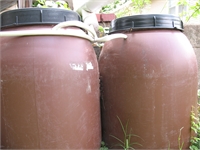
Tips for Reducing Household Water Usage
Important Notice: Our web hosting provider recently started charging us for additional visits, which was unexpected. In response, we're seeking donations. Depending on the situation, we may explore different monetization options for our Community and Expert Contributors. It's crucial to provide more returns for their expertise and offer more Expert Validated Answers or AI Validated Answers. Learn more about our hosting issue here.

Tips for Reducing Household Water Usage
You must be logged in to post a comment.
As the population continues to increase worldwide, there is a greater burden on natural resources,
many of which are necessary for life. Fresh water is one of these resources that is facing this
growing strain. Some believe that peak water will be reached soon, making sources of fresh water
more scarce for both animals and humans, along with the irrigation of farms and plants. Although
many interested in green living are aware of this possible crisis, it can often be confusing as to
how to make changes in personal habits to reduce water use. There are some simple changes that can
be made to lessen water usage in a household.
Perhaps the easiest change to be made is turning off the faucet when not in use, along with fixing
a dripping faucet. While possibly an obvious choice, turning off the faucet during such activities
as washing hands or brushing teeth will lower water usage. In addition, any faucet that is dripping
should be repaired. These actions may not produce a noticable drop in the short term but will make a
difference over the course of a year or so.
As with a leaky faucet, toilets must also be part of a household’s plan to reduce their water use.
If the toilet has any problems, such as running constantly, these should be fixed. Older toilets also
use much more water than newer ones, and so one should either replace the toilet or rig it so that
it functions more efficiently. Although repairing or replacing the toilet will do much to help lower
water usage, there is also one habit that can be considered. Some have begun flushing their toilets
less frequently, following the adage "If it’s yellow, let it mellow. If it’s brown flush it down.”
This may be unacceptable to some but can greatly help with water conservation.
Bath or shower time can also be problematic. Obviously, taking shorter showers and shallower baths will help. Additionally, a bucket can be put in the shower while the water is warming. This water can then be used for household chores, such as watering plants and cleaning. For immediate use, one could even consider using it for shaving. For instance, a woman who normally shaves in the shower while the water is running wastes a lot of water. She could turn off the water after the bucket is full and use the water in the bucket for her shaving needs. The shower can then be turned back on for rinsing. This method could also be used in anyone’s shower; he or she would get wet and then turn off the water while soaping, with the water only turned back on for rinsing. These habits can be hard to implement but can make significant gains in conservation.
Perhaps one of the greatest ways to reduce water usage is in the yard. While pretty, grass can require
a large amount of water for health. Xeriscaping or edible landscaping can make the yard more productive
while reducing the need for water. In addition, rain barrels can collect rain water for use in gardens.
Although many communities may look unfavorably at native plants, their presence in a yard can be
beneficial for the owner.
These are just a few suggestions for reducing water usage. While some, such as replacing a toilet, may
require money, most are habits that can be developed over time. With a little ingenuity and vigilance,
a household can be greener and more sustainable in their water needs. This effort will produce benefits
for not only the household budget but the environment as well.